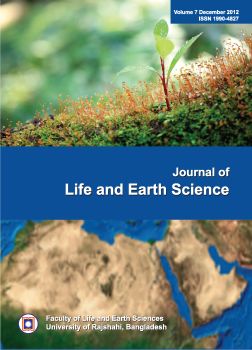Effect of Arsenic (NaAsO2) on the Histological Change of Snakehead Fish, Channa punctata
DOI:
https://doi.org/10.3329/jles.v7i0.20123Keywords:
Arsenic, Channa punctata, histology, fish pathologyAbstract
Sodium arsenite (NaAsO2) considered effective for aquatic weed control, has been found to be harmful to several species of freshwater teleost fishes. Channa punctata was exposed to NaAsO2 at the concentrations of 100?l/30g and 200?l//30g body weight per fish and cultured for 14 days post exposure respectively. Tissue disorientation, peliosis and vacuolization accompanied by karyolysis, apoptosis and necrosis in the liver and heart were significant on days onwards. Irregularities in the intestines including apoptotic and necrotic cells were also common, enlargement of the mucosa and submucosa was noted. Corresponding with the histopathological lesions, necrosis of liver cells and intestinal functions or induction of heart muscles at the early phase of arsenic exposure may be the possible causes of fish death.
DOI: http://dx.doi.org/10.3329/jles.v7i0.20123
J. Life Earth Sci., Vol. 7: 67-70, 2012
Downloads
226
354
Downloads
Published
How to Cite
Issue
Section
License
It is a condition of publication in the Journal that author(s) assigns copyright to the Faculty of Life and Earth Sciences, University of Rajshahi, whose permission must be obtained to reproduce there from. This would ensure efficient handling of reproduction of articles for third party requests and wide dissemination at large.

